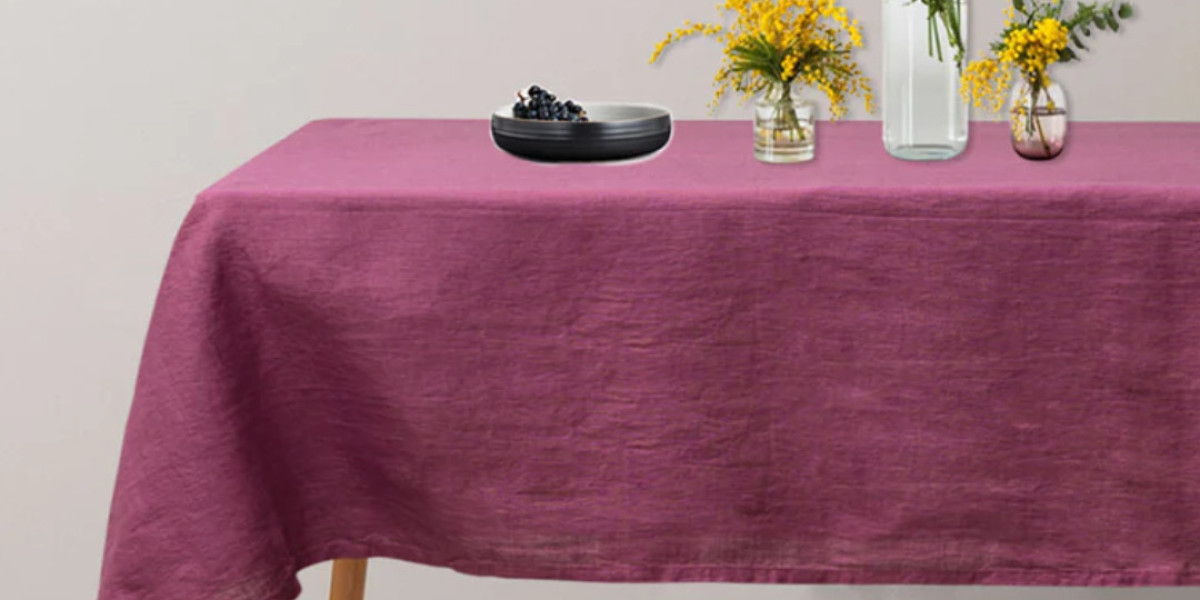Washing Your Cotton Tablecloths
Cotton is a durable and washable fabric, but it requires the right approach when cleaning to preserve its quality and longevity. Here are some essential tips for washing cotton tablecloths:
1. Read the Care Label
Before washing your cotton tablecloth, always check the care label. Most cotton tablecloths come with instructions regarding water temperature, washing machine settings, and whether they should be hand-washed or machine-washed. Following these guidelines will help you avoid shrinking, fading, or damaging the fabric.
2. Pre-Treat Stains
If your cotton tablecloth has any stains, it’s important to treat them before washing. Use a stain remover or pre-treatment spray, and apply it directly to the affected area. Let it sit for at least 15 minutes to penetrate the fabric before washing. Be sure to test the stain remover on a small, inconspicuous area of the tablecloth first to avoid discoloration.
3. Use Cold or Warm Water
For most cotton tablecloths, washing them in cold or lukewarm water is the best option. Hot water can cause cotton fabric to shrink, especially if the tablecloth has not been pre-shrunk. Cold water is gentler on the fabric and helps maintain the fabric’s color.
4. Choose a Gentle Detergent
Use a mild detergent that’s gentle on fabrics. Harsh detergents with bleach or strong chemicals can weaken cotton fibers over time. Opt for a detergent that is suitable for delicate fabrics to maintain the softness and durability of your cotton tablecloth.
5. Wash on a Gentle Cycle
To prevent damage to the fabric, it’s advisable to wash your cotton tablecloth on a gentle cycle. A slower spin cycle also helps reduce wrinkles, which makes ironing easier. If you prefer to wash your tablecloth by hand, use a gentle detergent and lukewarm water, gently agitating the fabric.
6. Avoid Overloading the Washing Machine
Overloading the washing machine can cause the fabric to become twisted and damaged. Give your cotton tablecloth plenty of space to move around in the wash to avoid tangling and stretching.
Stain Removal Tips
Cotton tablecloths are prone to stains, especially during meals. However, with the right stain removal techniques, you can easily get rid of most stains. Here are some common stains and how to treat them:
1. Red Wine Stains
Red wine stains are one of the most common problems, especially when entertaining guests. To remove a red wine stain, immediately blot the area with a clean cloth to soak up as much wine as possible. Sprinkle salt on the stain to absorb the wine. Then, apply a stain remover or rub some dish soap into the fabric before washing the tablecloth in cold water.
2. Grease and Oil Stains
Grease or oil stains can be tricky, but they’re not impossible to remove. First, sprinkle a generous amount of baking soda or cornstarch on the stain to absorb the grease. Let it sit for 10-15 minutes, then gently brush off the powder. Apply dish soap directly to the stain and scrub gently with a soft brush. Wash the tablecloth in warm water as usual.
3. Food Stains (Tomato Sauce, Curry, etc.)
For food stains like tomato sauce or curry, it’s essential to act quickly. Blot the stain gently with a paper towel to remove any excess food. Then, rinse the fabric under cold water to flush out the stain. For stubborn stains, create a mixture of baking soda and water and apply it directly to the stain. Let it sit for 10-15 minutes before washing the tablecloth.
4. Coffee or Tea Stains
Coffee and tea stains can leave unsightly marks on your cotton tablecloth. To remove these stains, gently blot the area with a clean cloth to absorb as much liquid as possible. Mix equal parts white vinegar and water, and apply it to the stain. Let it sit for a few minutes before washing in cold water.
5. Ink Stains
Ink stains can be one of the most challenging to remove, but it’s not impossible. Dab the stain with rubbing alcohol using a cotton ball or clean cloth. Rinse the area under cold water and repeat the process until the ink is removed. Once the stain is gone, wash the tablecloth as usual.
Drying Your Cotton Tablecloths
How you dry your cotton tablecloth also plays a crucial role in maintaining its appearance. Here are some tips for drying:
1. Air Drying
The best way to dry cotton tablecloths is by air-drying them. Lay the tablecloth flat on a clean, dry surface or hang it to dry. Air drying helps preserve the fabric’s texture and prevents it from shrinking, especially if it’s hung while slightly damp.
2. Tumble Drying
If you prefer to use a dryer, use the lowest heat setting possible. High heat can cause cotton to shrink, so it’s better to choose a gentle or low-heat setting. Remove the tablecloth from the dryer while it is still slightly damp to prevent over-drying and wrinkles.
3. Avoid Direct Sunlight
While air drying is ideal, avoid hanging your cotton tablecloth in direct sunlight for extended periods. Sun exposure can cause fading and weaken the fabric over time. Choose a shaded area or an indoor drying space for the best results.
Ironing and Storing Your Cotton Tablecloths
Once your cotton tablecloth is clean and dry, it’s important to iron and store it correctly to keep it in top condition.
1. Iron While Damp
To make ironing easier, iron your cotton tablecloth while it is still slightly damp. If it has already dried completely, mist it with water or use an iron with a steam function to dampen the fabric. This will help you remove wrinkles and restore the smooth texture of the tablecloth.
2. Store Properly
Store your cotton tablecloths in a cool, dry place to prevent moisture buildup, which can lead to mold or mildew. Fold the tablecloth neatly, or hang it on a hanger to avoid wrinkles. If you’re storing it for an extended period, consider using a cotton storage bag to protect the fabric from dust and dirt.
Conclusion
Proper care and maintenance of cotton tablecloths will ensure they stay beautiful and functional for years to come. Regular washing, timely stain removal, and correct drying techniques are essential to keep them looking their best. By following these tips, you’ll not only protect your cotton tablecloths but also enhance their longevity and usability. For high-quality cotton tablecloths, check out Cotton Tablecloth at AllCottonAndLine, where you can find a wide range of premium cotton tablecloths that are both stylish and durable. With the right care, your cotton tablecloths can continue to be a staple in your home, adding charm to every meal and gathering.







